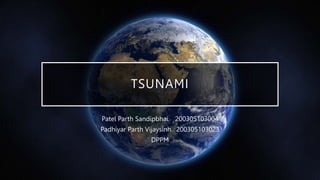
Here are the answers to your questions:1. A tsunami is a series of waves caused by the displacement of a large volume of water, typically in an ocean or a large lake.2. The average speed of a tsunami in the open ocean is over 970 kph (600 mph). 3. The main causes of tsunamis are earthquakes, volcanic eruptions and explosions, landslides, meteorite impacts, and glacial calving.4. Early tsunami warning systems involve seismic and sea level monitoring sensors that can detect tsunami-generating events and changes. This data is analyzed to determine if a tsunami warning should be issued. 5. If a ts
- 1. TSUNAMI Patel Parth Sandipbhai. 200305103004 Padhiyar Parth Vijaysinh. 200305103023 DPPM
- 3. CONTENT Introduction Facts History Causes of tsunami Conseqences of tsunami What to do when its tsunami Previous Tsunamis Early Warning System
- 4. INTRODUCTION A Tsunami is a series of waves in a water body caused by the displacement of large volume of water , generally in a ocean or a large lake. Tsunami is natural rapid disaster.
- 5. SOME FACTS The term seismic sea wave is also used to refer to the phenomenon because the waves most often are generated by seismic activity such as earthquakes. Tsunamis are sometimes referred to as tidal waves. This once-popular term derives from the most common appearance of a tsunami. A tsunami can travel at well over 970 kph (600 mph) in the open ocean – as fast as a jet flies. It can take only a few hours for a tsunami to travel across an entire ocean.
- 6. When they strike land, most tsunamis are less than 10 feet high, but in extreme cases, they can exceed 100 feet near their source. A tsunami may come onshore like a fast-rising flood. Tsunamis can have wavelengths ranging from 10 to 500 km. Amount of time that a tsunami wave takes to complete a cycle, or one wavelength. Tsunami periods typically range from 5-60 minutes.
- 7. HISTORY The origin of Tsunami word is as a Japanese word and made-up from two sub words “tsu” and “nami”. Where “tsu” is stands for Harbour and “nami” is stands for Wave. The first tsunami was recorded on 1480 B.C. in eastern Mediterranean ,when Minoan civilization wiped out.
- 11. CONSEQUENCES Loss of life and property :-- Tsunamis can have worst effects on life and property. This large displacement of water destroys housing and infrastructure in the areas affected by it. Many people lose their lives. Records say that since 1850, tsunamis have been responsible for the loss of more than 430,000 lives. Tsunamis cause collapsing of buildings, electrocution, gas leakage and explosions, damaging of tanks that further cause injury and death.
- 12. Disease – Tsunami causes flood in the affected areas and destroy the basic infrastructure like the sewage systems. Flooding and contamination caused due to the destruction of sewage systems cause outbreaks of diseases, infections and illness thus causing more death. Effect on environment and biodiversity – Tsunamis not only affect human beings but also cause harm to insects, animals, plants, and natural resources. Plants are uprooted due to violent waves of a tsunami, nesting sites are destroyed, land animals get killed by drowning and marine life is harmed by the flow of toxic chemicals into the waterbody. Solid waste and disaster debris are other critical environmental problems faced by a disaster-hit area. Economical Impact – Tsunami causes contamination of soil and water. It increases the salinity of the soil. The mixing up of disaster debris with the soil and high salinity makes the soil infertile and unfit for cultivation thus adding to financial loss to the farmers and raising the chances of food insecurity. Post-tsunami reconstruction :- It also requires a huge amount of financial investment. Thus, tsunami has a huge economic cost for an economy.
- 13. WHAT TO DO BEFORE,DURING,AFTER TSUNAMI????
- 15. WORST TSUNAMIS TILL DATE 1498 Enshunada sea (Japan) 1755 Lisbon (Portugal) 1883 Krakatau (Indonesia) 2004 Sumatra (Indonesia) 2011 North Pacific Coast (Japan)
- 16. IN DETAILS 1. Sumatra, Indonesia– 26 December 2004 Reason:- 9.1 magnitude earthquake Depth of 30 km. Tsunami was as tall as 50 m, reaching 5 km inland near Meubolah, Sumatra. US$10b of damages is attributed to the disaster Around 230,000 people reported dead.
- 17. 2. NorthPacific Coast,Japan – 11 March2011 Reason:- 9.0 magnitude earthquake Speed:- 800km per hour Height:-10 m high waves swept over the east coast of Japan Killed more than 18,000 people. The tsunami was spawned 24.4km. $235 billion damages. 3. Lisbon, Portugal – 1 November 1755 Reason:- 8.5 magnitude earthquake caused a series of three huge waves Height:-Up to 30 m high Tsunami killed 60,000 in the Portugal, Morocco and Spain.
- 18. EARLY WARNING SYSTEM There are two distinct types of early tsunami warning systems: 1) International 2) Regional Early tsunami warning systems starts with seismic monitoring. Sensors on the seafloor monitor for seismic activity caused by earthquakes and volcanoes. If any substantial seismic incident occurs, surface buoy sensors then monitor the changes in the sea level.
- 20. QUESTION-ANSWER 1. What is Tsunami? 2. What are the average speed of Tsunami? 3. What are the causes of Tsunami? 4. What is the early warning system for Tsunami? 5. What to do when its Tsunami?